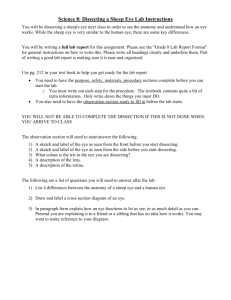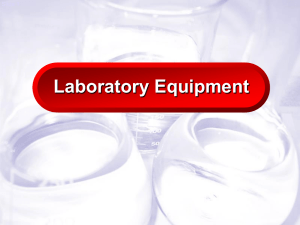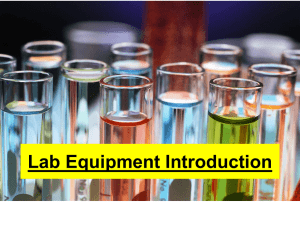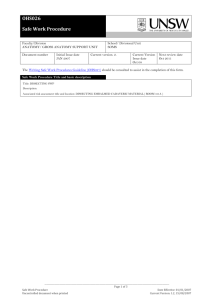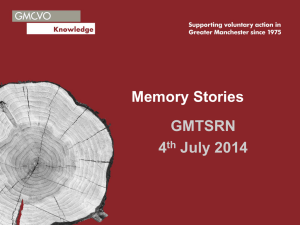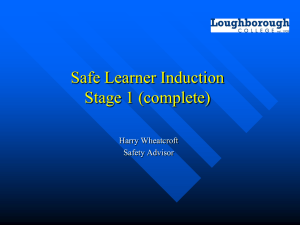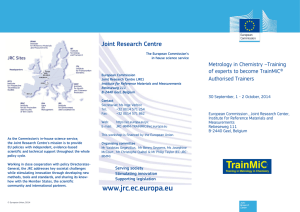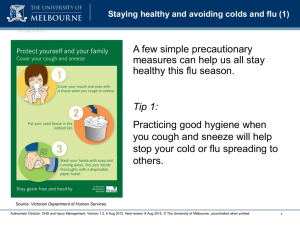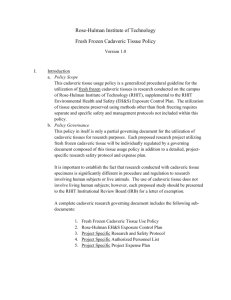Risk assessment form - Faculty of Medicine
advertisement
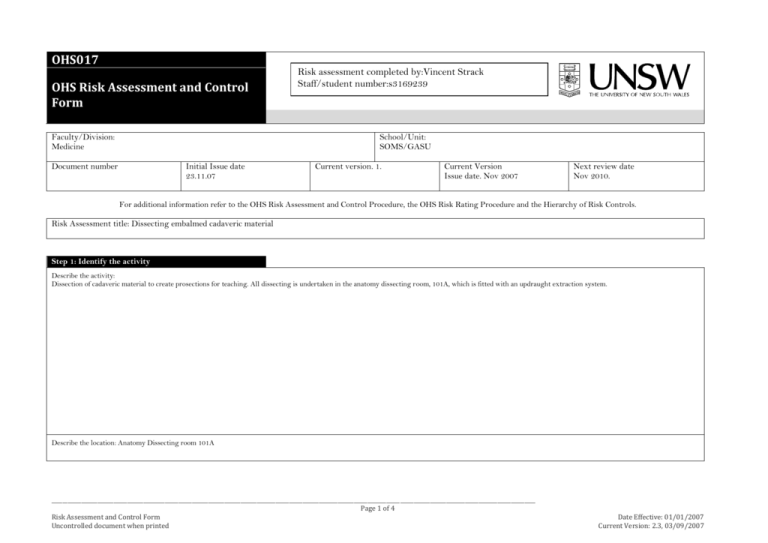
OHS017 OHS Risk Assessment and Control Form Faculty/Division: Medicine Risk assessment completed by:Vincent Strack Staff/student number:s3169239 School/Unit: SOMS/GASU Document number Initial Issue date 23.11.07 Current version. 1. Current Version Issue date. Nov 2007 Next review date Nov 2010. For additional information refer to the OHS Risk Assessment and Control Procedure, the OHS Risk Rating Procedure and the Hierarchy of Risk Controls. Risk Assessment title: Dissecting embalmed cadaveric material Step 1: Identify the activity Describe the activity: Dissection of cadaveric material to create prosections for teaching. All dissecting is undertaken in the anatomy dissecting room, 101A, which is fitted with an updraught extraction system. Describe the location: Anatomy Dissecting room 101A ___________________________________________________________________________________________________________________________________________________________________________________ Page 1 of 4 Risk Assessment and Control Form Uncontrolled document when printed Date Effective: 01/01/2007 Current Version: 2.3, 03/09/2007 Step 2: Identify who may be at risk by the activity A number of people may be at risk from any activity. This may affect the risk controls needed. These people may include fellow workers, visitors, contractors and the public. The location of the activity may affect the number of people at risk. Any person inside the Dissecting Room 101A may be affected by some of the hazards. This could include anatomy staff, medical students (ILP), student dissectors and academic staff. Steps 3 to 7: Identify the hazards, risks, and rate the risks 1. An activity may be divided into tasks. For each task identify the hazards and associated risks. 2. List existing risk controls and determine a risk rating using the UNSW Risk Rating Procedure. 3. Additional risk controls may be required to achieve an acceptable level of risk. Re-rate the risk if additional risk controls used. Tasks Hazards Associated risks (Step 3) (Step 4) Risk rating with existing controls * Additional risk controls required Risk Rating with additional controls * (Step 5) (Step 6) (Step 7) Existing risk controls C Handling of cadaveric material. Dissecting cadaveric material. Scalpel blade removal. R Potentially infectious material. Contraction of pathogens/disease. Wear PPE, latex gloves, labcoat & enclosed footwear. Wash hands after dissecting. No eating or drinking allowed. All cadaveric material has been blood screened and embalmed. 3 E M Instruments that can cause a cut or physical trauma. Cut or physical trauma. Infection. Strain injuries to muscles or eyes. Use of PPE, latex gloves, labcoat & enclosed footwear. Dissection training and supervision. Regular short breaks with stretching to avoid repetitive injuries. Use of sharps bins. An updraught extraction system. 2 C M Chemical vapours generated Sitting in dissecting chair. L Excessive inhalation of chemical vapours. Inappropriate ergonomics. Muscle strain. Back pain. Have fully adjustable ergonomic chairs. Take regular breaks & stretches. 1 C L Using a sharp object. Getting cut. The blade may hit a bystander. Use a blade removal unit. Training provided by suitable staff member. 2 D L (Apply the hierarchy of risk controls) ___________________________________________________________________________________________________________________________________________________________________________________ Page 2 of 4 Risk Assessment and Control Form Uncontrolled document when printed C L R Date Effective: 01/01/2007 Current Version: 2.3, 03/09/2007 Stitching skin onto a dissection. Needle. Sharps injury from needle. Training is provided. Use a needle holder. Wear PPE, latex gloves & enclosed footwear. 2 D L Using a ceiling mounted surgical light. Light Can hit your head on the light or handle. Eye strain from not enough light.or dissecting for an excessive period of time. Lift the light after a dissector is finished. Dissect in intervals taking regular small breaks. 2 D L Cutting bone with a burr drill. Burr Drill. Bone dust. Can drill your hand. Glove can get caught in burr drill. Inhalation or bone dust. Training and supervision is provided. PPE must be worn, latex gloves, labcoat, enclosed footwear, surgical mask & safety glasses. Spray bottle with water should be used to reduce bone dust. 2 D L Using a hand saw for gross dissection. Teeth on the saw. May cut your hand. Use PPE, latex gloves, labcoat, enclosed footwear & surgical mask. Training and supervision provided. Assistance is required for stability. 2 D L Cleaning up a dissector workstation. Scalpel with blade attached. Scalpel can cut anyone at workstation unaware of its presence. PPE must be worn. Most important is that the protocol outlined in the SWP for safely cleaning up a workstation is followed. 2 C M * C = consequence L = likelihood R = risk rating from the UNSW Risk Rating Procedure Step 8 Documentation and initial approval Completed by: (name) Vincent Strack (signature) Authorised by: (name) (signature) Date: Step 9: Implement the additional risk controls identified Indicate briefly what additional risk controls from Step 6 above were implemented, when and by whom. Risk control: Date: Implemented by: ___________________________________________________________________________________________________________________________________________________________________________________ Page 3 of 4 Risk Assessment and Control Form Uncontrolled document when printed Date Effective: 01/01/2007 Current Version: 2.3, 03/09/2007 Risk control: Date: Implemented by: Risk control: Date: Implemented by: Risk control: Date: Implemented by: Risk control: Date: Implemented by: Step 10: Monitor and review the risk controls It is important to monitor risk controls and review risk assessments regularly. Review is required when there is a change in the process, relevant legal changes, and where a cause for concern has arisen. Reviews could be scheduled on an annual basis. If the risk assessment has substantially changed a new risk assessment is warranted. Review date: Reviewed by: Authorised by: Review date: Reviewed by: Authorised by: Review date: Reviewed by: Authorised by: Review date: Reviewed by: Authorised by: Review date: Reviewed by: Authorised by: Documentation It is a requirement that legal and advisory documentation that supports this risk assessment be listed. Such documentation includes Acts, Regulations, Australian Standards and Codes of Practice, where applicable. NSW ANATOMY ACT 1977 INCLUDING SUBSEQUENT AMMENDMENTS; UNSW OHS & WC WEBSITE (ERGONOMICS/JOB DESIGN/ DISCOMFORT & OCCUPATIONAL OVERUSE INJURY) AS 1715:2009 SELECTION USE AND MAINTENANCE OF RESPIRATORY EQUIPMENT; NATIONAL CODE OF PRACTISE (FOR THE PREVENTION OF MUSCULOSKELETAL DISORDERS FROM PREFORMING MANUAL TASKS AT WORK: AUG 2007) AS/NZ 3825: 1998 PROCEDURES & DEVICES FOR THE REMOVAL & DISPOSAL OF SCALPEL BLADES FROM SCALPEL HANDLES: AS 4031 NON REUSABLE CONTAINERS FOR COLLECTION OF SHARP MEDICAL ITEMS. AS2243.3 SAFETY IN LABORATORIES: ___________________________________________________________________________________________________________________________________________________________________________________ Page 4 of 4 Risk Assessment and Control Form Uncontrolled document when printed Date Effective: 01/01/2007 Current Version: 2.3, 03/09/2007
